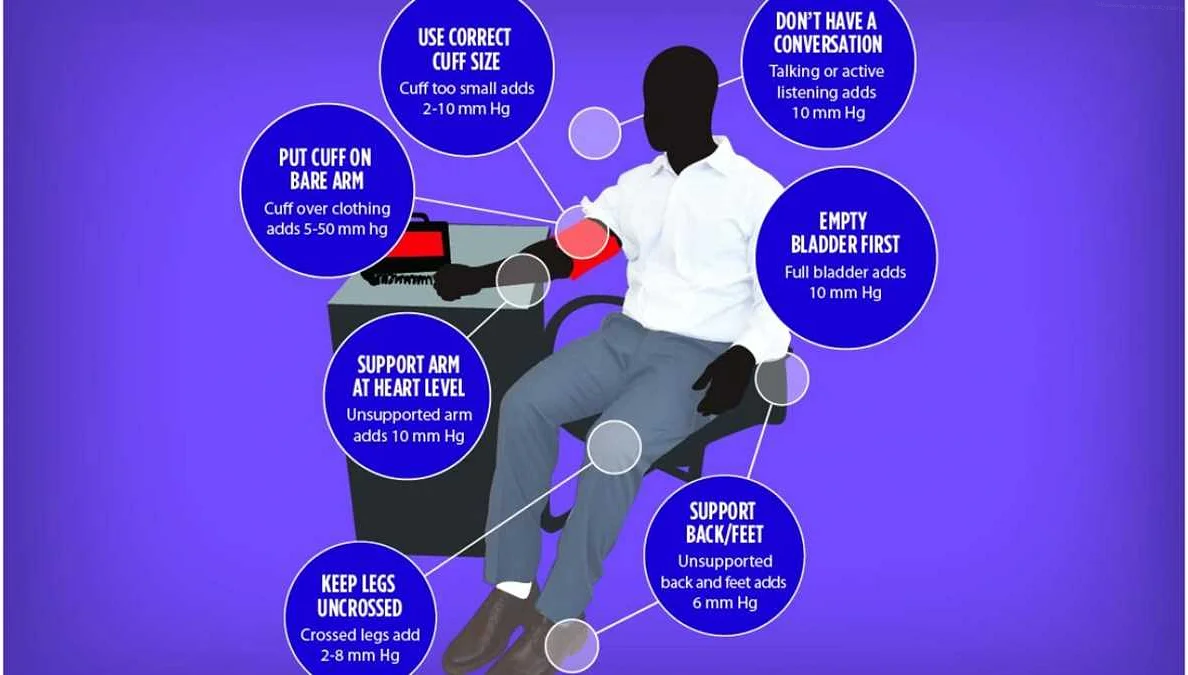Proper Techniques for Measuring Blood Pressure
Содержимое
Learn how to measure blood pressure correctly to get accurate results. Follow these steps and avoid common mistakes to ensure your readings are reliable and help manage your blood pressure effectively.
High blood pressure, also known as hypertension, is a serious health condition that affects millions of people worldwide. Monitoring your blood pressure regularly is essential in managing your overall health and preventing potential complications. However, measuring blood pressure correctly is crucial to obtaining accurate results.
Follow this step-by-step guide to learn how to measure your blood pressure correctly:
Step 1: Prepare
Begin by finding a quiet and comfortable space to measure your blood pressure. Make sure you have a functioning blood pressure monitor and a cuff that fits properly around your arm. Remove any tight clothing that may interfere with the accuracy of the measurements. Sit down and relax for at least five minutes before starting the measurement.
Step 2: Positioning
Place the cuff around your upper arm, approximately one inch above the bend of your elbow. Make sure it fits snugly but not too tight. Position your arm so that it is supported at heart level. Rest your arm on a table or armrest, ensuring that the cuff is at the same height as your heart.
Step 3: Taking the Measurement
Press the start button on your blood pressure monitor to begin the measurement. The cuff will inflate and then gradually deflate, while the monitor records your blood pressure. It is important to remain still and avoid talking or moving during the measurement. Keep your arm relaxed and do not tense your muscles.
Step 4: Recording the Results
Once the measurement is complete, the monitor will display your systolic and diastolic blood pressure readings. Systolic pressure represents the force of blood against your artery walls when the heart beats, while diastolic pressure represents the force when the heart is at rest between beats. Record these values along with the date and time in a blood pressure log or note them down for future reference.
Remember, measuring your blood pressure regularly and correctly is an important step in managing your overall health. If you have any concerns or questions about your blood pressure readings, consult with a healthcare professional for further guidance and support.
Why Measuring Blood Pressure is Important

Monitoring your blood pressure regularly is crucial for maintaining your overall health and preventing serious conditions.
High blood pressure, also known as hypertension, is often called the “silent killer” because it usually has no symptoms. If left untreated, high blood pressure can lead to serious health problems, including heart disease, stroke, and kidney failure.
By measuring your blood pressure regularly, you can identify any changes or abnormalities early on. This allows you to take necessary steps to manage and control your blood pressure before it escalates to dangerous levels.
Lowering high blood pressure can significantly reduce the risk of developing cardiovascular diseases.
Monitoring your blood pressure is especially important if you have certain risk factors, such as a family history of hypertension, obesity, smoking, or a sedentary lifestyle. It is also recommended for certain age groups, particularly individuals over the age of 40.
Regular blood pressure measurements can help you and your healthcare provider to make informed decisions about your treatment plan and lifestyle changes.
Remember, measuring your blood pressure is a simple and painless procedure that you can do at home with a blood pressure monitor. It only takes a few minutes but can provide valuable insights into your cardiovascular health.
Understanding Blood Pressure
Blood pressure is a measure of the force that blood exerts on the walls of the arteries as it is pumped through the body. It is important to understand how blood pressure is measured and what the numbers mean in order to monitor and maintain good cardiovascular health.
When blood pressure is measured, it is typically given as two numbers: systolic pressure over diastolic pressure. The systolic pressure is the higher number and represents the force exerted on the artery walls when the heart contracts and pumps blood. The diastolic pressure is the lower number and represents the force exerted on the artery walls when the heart is at rest between beats.
The unit of measurement for blood pressure is millimeters of mercury (mmHg). A normal blood pressure reading is typically around 120/80 mmHg. However, blood pressure can vary depending on factors such as age, gender, and overall health.
High blood pressure, also known as hypertension, is a condition in which the force of blood against the artery walls is consistently too high. This can put strain on the heart and blood vessels, increasing the risk of heart disease, stroke, and other serious health issues. Low blood pressure, or hypotension, is a condition in which blood pressure is consistently lower than normal, which can cause dizziness, fainting, and other symptoms.
Regular blood pressure monitoring is important for detecting and managing high or low blood pressure. By understanding blood pressure and its measurements, individuals can take steps to maintain a healthy lifestyle and work with healthcare professionals to address any concerns or potential risks.
| Less than 120 | Less than 80 | Normal |
| 120-129 | Less than 80 | Elevated |
| 130-139 | 80-89 | Stage 1 Hypertension |
| 140 or higher | 90 or higher | Stage 2 Hypertension |
| Higher than 180 | Higher than 120 | Hypertensive Crisis |
Benefits of Accurate Blood Pressure Measurement
Accurate blood pressure measurement is essential for maintaining good health and managing various medical conditions. Here are some key benefits of measuring blood pressure accurately:
- Diagnosis and Treatment: Accurate blood pressure measurement helps in the diagnosis of hypertension, allowing healthcare professionals to provide appropriate treatment and interventions.
- Monitoring Health: Regular blood pressure measurement can help individuals monitor their health and detect any changes in blood pressure levels, enabling early intervention and prevention of complications.
- Medication Management: Accurate blood pressure measurement ensures that the prescribed medications are effective in controlling blood pressure and allows for necessary adjustments in dosage or medication regimen.
- Heart Disease Prevention: High blood pressure is a significant risk factor for heart disease. Accurate measurement helps in identifying individuals with high blood pressure and implementing preventive measures to reduce the risk of heart-related complications.
- Stroke Prevention: Hypertension is a leading cause of strokes. Regular and accurate blood pressure measurement can help identify individuals at a higher risk of stroke and enable timely interventions to prevent its occurrence.
- Overall Health Management: Accurate blood pressure measurement is an integral part of managing overall health. It provides valuable information about the functioning of the cardiovascular system and helps in making informed decisions regarding lifestyle modifications and treatment plans.
Given the numerous benefits, it is essential to ensure that blood pressure is measured accurately using recommended techniques and reliable instruments. This helps in obtaining accurate readings, facilitating proper diagnosis, treatment, and overall health management.
Choosing the Right Blood Pressure Monitor

When it comes to measuring blood pressure at home, it is important to choose the right blood pressure monitor. With so many options available on the market, selecting the right one can be overwhelming. Here are some factors to consider when making your decision:
| Type of Monitor | There are two types of blood pressure monitors: manual and automatic. Manual monitors require you to inflate the cuff manually, while automatic monitors inflate the cuff automatically. Automatic monitors are generally easier and more convenient to use, especially for those with limited dexterity. |
| Accuracy | Accuracy is crucial when it comes to measuring blood pressure. Look for monitors that have been validated and approved by reputable organizations such as the Association for the Advancement of Medical Instrumentation (AAMI) or the British Hypertension Society (BHS). |
| Cuff Size | The cuff size is an important consideration, as an ill-fitting cuff can lead to inaccurate readings. Make sure to measure the circumference of your upper arm and choose a cuff size that fits properly. Most monitors come with a standard-sized cuff, but larger or smaller cuffs may be available for purchase separately. |
| Features | Consider the features that are important to you. Some monitors offer memory functions to store previous readings, while others may have a built-in irregular heartbeat detector. Think about your specific needs and choose a monitor that meets them. |
| Cost | While cost is not always an indicator of quality, it is still an important factor to consider. Set a budget and look for a monitor that offers good value for your money. Compare prices and read customer reviews to make an informed decision. |
By taking these factors into account, you can choose a blood pressure monitor that suits your needs and allows for accurate measurements in the comfort of your own home.